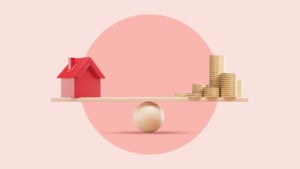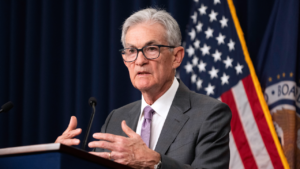Here’s what it means when a bank gets a loan from the Fed’s discount window

You’ve probably heard people refer to the Federal Reserve as the bank’s bank, but the reason why might not be as obvious.
That’s because it refers to one of the more inconspicuous duties of the U.S. central bank: serving as a lender of last resort. In other words, if banks face a cash crunch and have no other means of finding money, the Fed provides them with a loan. This lending facility is more casually known as the “discount window,” and it’s designed to prevent depository institutions from failing due to shortages.
The lending facility doesn’t just exist during economic turmoil. Banks can utilize the discount window at any stage of the business cycle, though these loans took on an even greater importance during the financial crisis.
Still, when a bank participates in the discount window, it comes with implications for both depositors and investors. The process itself is also shrouded in stigma, and some experts say it might be a bad sign. Here’s everything you need to know about the Fed’s discount window and what it means if a bank participates in it.
The Fed’s discount window explained
Your bank may require you to maintain a minimum balance in your checking account every night. In a sense, that’s exactly what the Fed requires of banks across the financial system.
The Fed’s board of governors requires that banks keep extra funds on hand each night; the amount normally depends on a firm’s total deposits. For example, banks with more than $124.2 million in deposits have to maintain reserves that are 10 percent of that total, while institutions with between $16.3 million and $124.2 million must maintain a 3 percent ratio.
If banks face any kinds of liquidity shortages that prevent them from meeting these overnight requirements, they can typically borrow from each other over the short term. But sometimes, external market forces or business conditions prevent that from happening. That’s where the Fed’s discount window comes in: Banks approach the Fed for money.
“Banks are only supposed to go to the discount window as a last resort,” says Jim Barth, professor of finance at Auburn University who specializes in financial systems and economic developments. “That means you’re solvent, but you’re not able to get liquidity in the general marketplace or from other banks, so you turn to the Fed.”
[COMPARE: Best high-yield savings account rates]
How the Fed’s discount window works
Banks have to offer up collateral in exchange for loans. They’ve traditionally exchanged U.S. Treasury notes and commercial loans but can also use assets such as residential mortgages and mortgage-backed securities. The Fed has to approve what’s used.
Institutions also have access to three different types of lending programs: primary, secondary and seasonal credit. Firms are typically charged an interest rate that’s higher than the federal funds rate — the Fed’s main policymaking tool that was lowered Sept. 18 to a target range of 1.75 percent and 2 percent. That’s meant primarily to disincentivize banks from borrowing from the lending facility and instead nudge them to borrow from the market, Barth says.
The primary rate is typically 50 basis points (or half of a percentage point) higher than the fed funds rate, while the secondary rate is 1 percentage point higher. During financial emergencies, however, it can be lowered or adjusted at the Fed’s discretion. The length of each loan can also be extended, as it was upped to 90 days during the crisis, instead of just overnight.
Primary credit is considered the looser of the three options because it’s meant for banks in solid condition. Unless the request raises any major red flags, most banks also have very few administrative hurdles to jump through. Fed administration officials also typically don’t ask the bank questions about why they’re borrowing, according to the Fed.
Secondary credit comes with more restrictions. It’s the only option for banks that aren’t eligible for primary credit. Fed administration asks banks about their overall financial situation and reasons for borrowing, and banks typically need to prove that they’ve sought funding elsewhere. The Fed also wants to know that the bank will soon return to normal market operations for funding their liquidity needs.
Banks aren’t allowed to use secondary credit to expand their assets, and the Fed is pickier about what kinds of collateral it accepts in exchange for funding.
Seasonal credit, meanwhile, is exactly what it sounds like: It helps banks respond to seasonal swings in their lending and deposits activities.
“There are seasonal movements that help explain discount window borrowing,” Barth says. “Agriculture banks may turn [to the window] when there’s a demand for liquidity by their customers. Around holiday times, customers take out deposits to buy presents and gifts.”
That interest rate is based on market-driven factors, and it’s reset every two weeks. Seasonal lending programs are mainly meant for smaller banks of less than $500 million in deposits, according to the Fed, and they can borrow for up to nine months of the year to meet the needs of their communities.
How the Fed’s discount window came about
The discount window has been around since the Fed was formed in 1913, and for decades, it was the Fed’s main policymaking tool rather than the fed funds rate. Banks back then approached physical windows inside regional Fed banks for loans.
“When the Fed was established here in the U.S., its purpose was mainly to provide liquidity to the banks in times of need,” Barth says. “It was established to prevent runs on banks or to deal with runs on banks.”
The interest rate on discount window loans was also below that of the fed funds rate by about 25 to 50 basis points, incentivizing banks to borrow from the Fed, according to the New York Fed. The program, however, was restructured into its current form in 2003, with many of the changes designed to make the discount window more of a “last resort” lending option.
[READ: How the Federal Reserve impacts savings accounts]
Why there’s a stigma to using the discount window
Many experts raise their eyebrows when a bank participates in the Fed’s discount window. The very nature of the program being deemed a “loan of last resort” makes a bank’s participation seem like a bad sign.
“If a bank is completely healthy, it should not have any reason to call the discount window for funds,” says Carl Tannenbaum, chief economist at Chicago-based bank Northern Trust. “The Fed wants to promote the notion that institutions should be self-sufficient. It’s expensive to go to the window.”
Typical logic goes like this: Why would a bank pay more to borrow from the Fed’s discount window, when other interest rates on the market are cheaper? Unless it’s to address seasonal business swings, do other depository institutions not want to do business with the bank, or is it on the brink of insolvency?
“If the discount rate is higher than banks are paying in the marketplace, then of course, you think there must be something about that bank,” Barth says. “What you’re doing is using interest rates basically to discourage borrowing because you can go into the private marketplace rather than the discount window, and borrowing is cheaper. It’s a penalty rate. It’s as if the bank somehow hasn’t been conducting its business properly, otherwise, why should it have it to turn to the Fed to borrow money?”
Why banks participate in the Fed’s discount window
Just because a bank participates in the program doesn’t mean it’s on the verge of collapse, says Walker Todd, an adjunct scholar at the Cato Institute who formerly worked as an attorney at the Cleveland and New York Fed supervising discount windows.
For example, sometimes banks are approached by developers or companies who request a large loan. A bank might not then have enough in cash to make the loan and meet its reserve requirements.
“Borrowing for that purpose doesn’t mean the bank is insolvent,” Todd says. “That’s an extreme case, but it would be legitimate if the loan made sense.”
It could also depend on market-driven factors. In more extreme cases, there’s the chance that other banks are experiencing simultaneous cash shortages, Barth says. That happened during the financial crisis. Banks weren’t lending with each other, so the Fed loosened discount window borrowing as a result.
Banks also could choose to sell off some of their assets if they’re strapped for cash, but if all of them are doing that at the same time, the value of those assets could fall, Barth says. That means they can’t sell off other assets to meet reserve requirements.
Should you be worried?
Naturally, there are instances when a bank’s participation in the program might be worrisome. It all depends on how many banks are participating at the same time, how big those banks are and the frequency of which they borrow from the window, Barth says.
It typically doesn’t raise any alarm bells if a few small banks participate in the program, but if a portion of the big banks — such as Goldman Sachs, JPMorgan Chase and Bank of America — all seek loans from the Fed, that could be a bad sign, he says.
The top 15 largest banks held a combined total $13.7 trillion in assets as of May, enough to buy everyone in the world a MacBook Pro, according to Bankrate’s Amanda Dixon, senior consumer banking reporter. The top 15 banks also make up more than half of the industry based off of assets, according to the Fed.
“One would say, ‘Is there something happening in the banking sector that we don’t know about?’” Barth says.
In the U.S., there are 5,303 banks insured by the Federal Deposit Insurance Corp., according to June data from the FDIC. If thousands of those banks started participating in the window at once, regardless of their size, that might also be a sign of trouble.
Repeated borrowing is perhaps the biggest red flag of all. If the Fed is lending to a bank multiple times for more than just seasonal reasons, that might indicate a bank is more than just illiquid but also having trouble maintaining excess reserves and obtaining funds through the market.
“It’s sort of like someone who maxes out on one credit card and gets a second credit card, maxes that one out, and gets a third or fourth or fifth,” Barth says. “Obviously, what’s the problem? Why is it that you need to be borrowing from the Fed on a more frequent basis?”
How to find out if your bank participates
The Fed used to keep discount window operations private, likely because of these stigmas but to also maintain strong relations with regional banks.
“The banking industry was reluctant to share trade secrets,” Todd says. “The bankers asked them to keep quiet and the Fed did. It was just enough trust so that the banks would come to the Fed in a time of need, instead of waiting until it was too late, and there were lines of depositors out the door.”
But during the financial crisis, that changed. In accordance with the Dodd-Frank Act of 2010, the Fed must disclose discount window lending information. The Fed releases this information quarterly with less than a two-year lag, as long as the Fed Chair determines that it’s in the public’s interest and the information won’t harm the purpose or conduct of the discount window.
The Board of Governors in Washington, D.C., reports total borrowing under each lending program for the nation, as well as the sum of borrowing under all programs for each Fed district. Regulators, however, are allowed to obtain information about various institutions’ borrowing history when they’re looking into a case.
In the second quarter of 2017, the most recent date for which information is available, 905 banks participated in the Fed’s discount window. More than 16 percent, or 147, of those transactions were cases of repeat borrowing for reasons other than seasonal credit.
What this means for you
Don’t worry too much. If your bank participates in the discount window or even if its participation in the program looks like it could raise a red flag, your money is safe thanks to the FDIC. The independent agency provides depositors with insurance on deposits totaling up to $250,000.
“You have nothing to worry about if you walk in and see an FDIC plaque on the wall of the bank,” Barth says. “That’s why we didn’t have massive runs on banks.”
But that’s only if your money is FDIC insured, which isn’t a requirement for banks. If your bank isn’t insured, and it appears at-risk based on the Fed’s available discount window data, you might want to find a bank that can guarantee your deposits are safe.
If you own stocks in one of these banks, however, you might not want to turn a blind eye. Investors who have money in bank stocks are likely the ones who care the most about discount window lending; they want to make sure that they’re invested in something sound and reliable that can offer returns. Bank employees might be fearful about it too, partially because their jobs could be on the line and their employers may offer benefits such as stock options, Barth says.
“If the bank is seized Friday afternoon and reopens, many people have no idea or even care that the bank failed. But if you own stock in that bank, you just got wiped out,” Barth says. “Even if you don’t own individual stocks in a bank, you may through a pension fund or a mutual fund.”
Investing in banks is tricky because its market value — its stock price multiplied by the number of shares outstanding — can be different than its book value, which is the total value of the bank based on its assets and liabilities. If a bank needs to take advantage of repeat borrowing, its book value might be worth less than its market value, Barth says, and that might matter to investors.
“Every market participant is trying to determine the value of something,” Barth says. “If lending starts to be repetitive over time, you ask yourself, is the value of that bank too high? Is the stock price too high? Should I sell my stock in that bank, or short that stock? Do you think that bank is doing well, or is it worth more than its accounts seem to be paying?”
Still, regardless of the criticisms or implications for your wallet, the discount window serves an important purpose for the overall plumbing of the financial system. It can often prevent bank failures and insolvency.
“There are payments that have to be made by banks all the time,” Barth says. “You have to pay your employees. You have to pay a lot of businesses who supply you with products and services. There are interest payments, withdrawals. Banks need liquidity, and they turn to the discount window for those payments.”
Learn more:
- 8 best low risk investments in September 2019
- How the FDIC protects your money
- Here’s how you can protect your savings from future rate decreases with a CD
Why we ask for feedback Your feedback helps us improve our content and services. It takes less than a minute to complete.
Your responses are anonymous and will only be used for improving our website.






